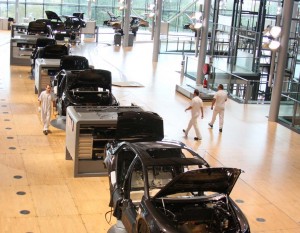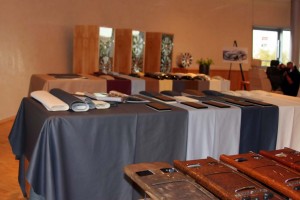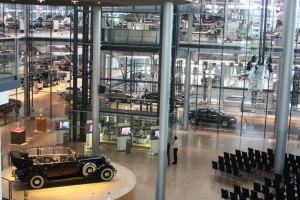
The Transparent Factory has soft Canadian maple floors. Operating at a fraction of capacity, workers are quite "relaxed," says one manager.
Volkswagen officials like to boast that their Glaserne Manufaktur, or Transparent Factory, is “the most modern manufacturing plant in the world.” Perhaps so, but at least among mainstream auto manufacturers, it is undoubtedly the least efficient.
The striking, glass-walled assembly line, built a stone’s throw from the reborn city of Dresden, Germany, was designed to produce VW’s first true luxury car, the Phaeton. The project has had as much to do with corporate ego as with corporate earnings.
Though the Phaeton has been pulled from the U.S. market, a victim of nearly non-existent sales, VW continues to produce it for Europe and a few other markets, albeit at a glacial pace of just 24 vehicles a day, barely a quarter of what the plant was designed for – and even that was a figure company officials privately admit would have been difficult to earn a profit on.
But the facility is nonetheless a striking example of what can be done if money is no object and you’re focused as much on image – and willing to keep your powerful labor unions happy – as anything else.
The Phaeton was intended to be the most expensive product ever sold under the Volkswagen badge, a leap of both faith and sticker pricing. In the U.S., that meant roughly tripling the sticker of what was then the marque’s most costly model, the Passat – though the Touareg SUV has since filled the gap.
Sharing some of the underpinnings of the lavish Bentley Continental – the luxury marque one of nine brands owned by Volkswagen AG – Phaeton was to be more than a costly mainstream offering, but a vehicle that shared some of the bespoke features of the British luxury offering.
So a centerpiece of the Transparent Factory is an order center where potential customers can come to spec out their new sedan. There are tables covered with wood and leather samples in an array of colors and textures, and stands full of different wheel options.
Officials insist they have no hard data on the number of customers who actually take advantage of the order center, though they do know that as many as 80% of those who have bought a Phaeton come to scenic Dresden – which has largely been rebuilt after being firebombed by the Allies during World War II – to watch their cars being built and then drive them home.

Also known as the Glass House, the Dresden facility includes an order center where Phaeton buyers can choose woods, leathers and wheels.
Watching the production process is certainly more fun than watching paint dry, but it’s no faster, as became apparent during a visit to the Transparent Factory – known to Germans as the “Glass House.”
The $186 million facility – the Phaeton itself reportedly cost about $500 million to develop – is now operating at less than a quarter of its capacity. In functional terms, that means the assembly line creeps forward at a nearly invisible 0.5 meters a minute. Unlike today’s typical, single-story assembly plants, each Phaeton rolls along three circuits on three separate floors, each taking a day to complete.
There are 400 VW employees at the visually-striking facility, half working on the assembly line. At the current rate of operation, they have a lot of “relaxed time,” according to Christian Vier, a manager who led the tour. “Because work is slow, they walk around a bit.”
Luckily for them, the floor of the facility is finished in Canadian maple, chosen specifically because it is easier on the feet than traditional concrete plant floors – and perhaps because it looks better at the showcase facility, where 120,000 visitors come to watch the operation each year.
What they see is a simple yet strikingly modern display of glass, wood and steel that stands in sharp contrast to Dresden’s minutely-detailed, baroque castles and cathedrals.
But the operation has more in common with old world craftwork than modern assembly operations, producing barely as many cars in a week as roll out of some other VW factories in a single hour.
Considering the likely cost of keeping the Dresden factory running, — and Phaeton in the line-up – it’s difficult for outsiders to understand why it remains open. VW tried to pick up the pace, in 2006, by adding production of the then-new Bentley Flying Spur, but that was a temporary measure. Even at the Phaeton’s peak, in 2008, sales – and production – barely topped 6,000.
Of course, it helps to understand that both Phaeton and the Transparent Factory were pet projects of former VW CEO Ferdinand Piech, grandchild of Ferdinand Porsche and still head of the company’s all-powerful supervisory board.
Economics ultimately played the trump card, VW pulling Phaeton out of the U.S. market. But the company insists it won’t abandon the nameplate, and CEO Martin Winterkorn has indicated there will eventually be a replacement vehicle that – the company hopes – will do a better job at winning over skeptical buyers who have yet to be convinced a luxury car can wear the same badge as the old Beetle.
Whether that new model would continue to be built in Dresden remains to be seen, but for the moment, the company also remains committed to the facility which, despite its problems, makes working on an assembly line almost seem like fun.
Can Volkswagen topple global sales leader Toyota? That’s its goal. Click here for the story.

